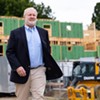Former Burlington mayor Miro Weinberger is the face of a new group that is trying to get more housing built in Vermont. Let’s Build Homes launched on Tuesday with a Statehouse press conference that brought together major employers, nonprofits and policy leaders.
The nonpartisan coalition wants 30,000 new homes to be built by 2030, a goal first set by Vermont Housing Finance Agency in early 2023.
That would require developers to more than double the rate of housing construction from the last 15 years, said Weinberger. A former affordable housing developer before serving 12 years as mayor, he added that many of Vermont’s problems, including a shrinking workforce and tax base, can be traced to its lack of affordable housing. Vermont had one of the highest rates of homelessness in the country last year, according to VHFA.
“There are so many interests that are negatively impacted by Vermont’s housing shortage, and the goal of this group is to represent all of them,” Weinberger said. He said the donation-funded group will advocate in the Statehouse and in community settings.
“We hope to not only change policy, but to change the way Vermonters think about the future of the state,” he said.
Vermont Cities and Towns Try to Ease Home Construction Costs

Vermont Cities and Towns Try to Ease Home Construction Costs
By Anne Wallace Allen
Real Estate
About 250 individuals and organizations, including major employers such as the University of Vermont Medical Center, Middlebury College and Vermont Gas, have signed on as supporters of Let’s Build Homes. The press conference also brought together construction company CEOs, bankers and nonprofit leaders.
“This is about convening and combining thought leaders across the state to help solve a statewide problem,” said David Provost, executive vice president of finance and administration at Middlebury College.
Some people fear homebuilding efforts will result in new skyscrapers, he said. But it will make homes more accessible to all types of workers and income levels, Provost said.
“We’re talking about affording today’s Vermonters the same rights and privileges my parents were granted back in the ’60s and ’70s,” said Provost, who grew up in Montpelier.
Policymakers and community leaders have been trying to promote housing construction for several years, and have passed several laws aimed at easing regulatory obstacles and mitigating costs. Affordable housing agencies such as Champlain Housing Trust have built hundreds of new apartments in the last several years. Private developers are also building new homes, mostly in Chittenden County.
Housing campaigns are already under way. CHT, nonprofit housing lender Evernorth and the Chittenden County Regional Planning Commission launched Building Homes Together in 2016. But the shortage remains stubbornly difficult to resolve.
Weinberger said the new group’s efforts will be distinct because the Let’s Build Homes coalition is broader, including viewpoints as diverse as VHFA and the Burlington-area nonprofit Vermonters for People Oriented Places, or VPOP.
Maura Collins, VHFA’s executive director, is also on the new group’s steering committee. She said it’s not growth that eventually would make Vermont unrecognizable to today’s residents — it’s stagnation.
“There is this mistaken belief that if we don’t built it, they won’t come, that by limiting housing we’ll somehow pause any changes to Vermont,” Collins said at the press conference. The opposite is true, she said.
“If we continue to not build homes, it won’t be us who live here in the future. It will be the playground of the rich and famous. They will ski and bike and enjoy all that our great state has to offer, but the moderate-income workers who serve those lucky few will struggle to live here.”
Cities and Towns Plead for State Help in Handling Homelessness

Cities and Towns Plead for State Help in Handling Homelessness
By Anne Wallace Allen
Housing Crisis
Weinberger said the policy steps taken in the Statehouse over the last several years are just a start. One focus of Let’s Build Homes is the outcome of last year’s Act 181, which calls for the regional planning commissions to create maps that will show which areas should be the focus of infrastructure investment aimed at easing the cost of home construction.
“This group is going to work at the state, regional and local level, to ensure these maps are drawn in a way that deliver more housing opportunity,” Weinberger said in an interview on Monday. He’d also like to streamline Vermont’s tax-increment financing rules, which use public funding to create investments expected to yield higher property tax revenues when they’re completed. Policymakers have sought to simplify Vermont’s TIF rules in prior years.
“We have an extremely complex and convoluted TIF tool that is an outlier nationwide in its limitations,” he said. “That has to change.” Let’s Build Homes will also strive to simplify permitting so that projects only have to go through one review — either the state’s Act 250 land use process or local permitting — and not both.
“That’s one of the things that has held Vermont back,” Weinberger said. “There’s really not another example in the country like Vermont’s system where most major projects need to go through a local comprehensive zoning review and essentially a very similar process at the state level.”
Some have worried that efforts to build large developments will irreparably change the look and feel of the rural state. Discussions about making Vermont more affordable and livable inevitably pit housing advocates against environmentalists. Weinberger said Let’s Build Homes will help facilitate that conversation.
Burlington real estate advisor David White, who has worked on many of Vermont’s TIF projects, said cultural change is vital. But that happens slowly, and Vermont needs some quick solutions.
White noted that voters showed in the November election that they were fed up with Vermont’s high property taxes and unaffordable housing market.
“I think there’s a willingness to look at some legislative changes,” he said.
